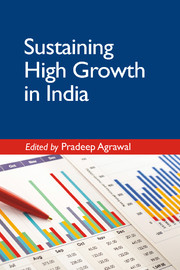Book contents
- Frontmatter
- Contents
- List of Tables
- List of Graphs and Maps
- Preface
- Introduction
- Section 1 Ensuring Macroeconomic Stability for Sustaining High Growth Rates
- Section 2 Promoting Industrial Development for Sustaining High Growth Rates
- Section 3 The International Economic Issues and Sustaining High Growth
- 6 Global Recession and the Eurozone Debt Crisis: Impact on Exports of India and China
- 7 Changing Global Trade Regime and Emergence of Mega FTAs: Strategy for India's External Sector Sustainability
- 8 Economic Impact of Foreign Capital Inflows in Emerging Asia
- 9 FDI Outflows from the BRIC Countries: Impact on Domestic Capital Formation
- Section 4 Infrastructure Bottlenecks to Sustaining High Growth
- Section 5 Some Socio-political Issues in Sustaining High Growth
- List of Contributors
- Obituary
- Index
8 - Economic Impact of Foreign Capital Inflows in Emerging Asia
from Section 3 - The International Economic Issues and Sustaining High Growth
Published online by Cambridge University Press: 08 February 2018
- Frontmatter
- Contents
- List of Tables
- List of Graphs and Maps
- Preface
- Introduction
- Section 1 Ensuring Macroeconomic Stability for Sustaining High Growth Rates
- Section 2 Promoting Industrial Development for Sustaining High Growth Rates
- Section 3 The International Economic Issues and Sustaining High Growth
- 6 Global Recession and the Eurozone Debt Crisis: Impact on Exports of India and China
- 7 Changing Global Trade Regime and Emergence of Mega FTAs: Strategy for India's External Sector Sustainability
- 8 Economic Impact of Foreign Capital Inflows in Emerging Asia
- 9 FDI Outflows from the BRIC Countries: Impact on Domestic Capital Formation
- Section 4 Infrastructure Bottlenecks to Sustaining High Growth
- Section 5 Some Socio-political Issues in Sustaining High Growth
- List of Contributors
- Obituary
- Index
Summary
INTRODUCTION
The impact of Foreign Capital Inflows (FCI) on economic growth of developing countries has continued to occupy a central position in the literature dealing with development problems of our time. However, questions asked by researchers in this respect have changed with changes in the predominant form of foreign capital resources available to developing countries.
In the context of the emerging Asian countries, foreign inflows used to be mainly in the form of foreign borrowing. However, recently foreign inflows like FDI and Foreign Portfolio Investment (FPI) have started to play a more important role. Many economists have hailed FDI as an important source of new technology and management know-how and a useful link to the world markets. On the other hand, concerns have also been voiced about whether the multinational firms and foreign portfolio investors might earn excessive profits, or adversely affect the development of domestic firms (in case of FDI) or otherwise be a source of economic exploitation of the developing countries.
Thus, it is important that we better understand the economic role of FDI and FPI in the Asian countries. Some of the important issues of contention are as follows:
1. How do FDI and FPI inflows affect domestic investment? Does FDI increases or decreases investment by local citizens?
2. Does FDI and FPI inflows increase GDP growth by increasing investment, creating jobs, increasing exports, bringing new management techniques, etc., or do they lower GDP growth in the long run by taking excessive profits out of the developing countries.
There are a few studies which have empirically examined the effect of FDI in the Asian countries. Among these, Baharumshah and Thanoon (2006) analyzed the effect of various types of capital flows on the growth process of the East Asian countries using dynamic panel data for eight Asian countries for the period 1982–2001. Overall, they concluded that countries that are successfully attracting FDI can finance investment and grow faster than those that deter FDI. They also found that short-term capital inflows have adverse effect on the long-term, as well as short-term growth prospects, although long-term debt has positive effect on growth, its effect does somewhat disappear in the long-term. Anusorn Tamajai (2000) considered the impact of capital flows on economic growth in selected Asian countries for the period 1980–1998.
- Type
- Chapter
- Information
- Sustaining High Growth in India , pp. 235 - 256Publisher: Cambridge University PressPrint publication year: 2017



